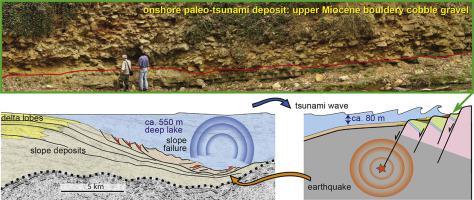当前位置:
X-MOL 学术
›
Glob. Planet. Change
›
论文详情
Our official English website, www.x-mol.net, welcomes your feedback! (Note: you will need to create a separate account there.)
Facies and implications of a coarse-grained lacustrine onshore paleo-tsunamiite: An integrated study of an upper Miocene bouldery cobble gravel
Global and Planetary Change ( IF 3.9 ) Pub Date : 2020-12-01 , DOI: 10.1016/j.gloplacha.2020.103321 Orsolya Sztanó , Soma Budai , Imre Magyar , Gábor Csillag , Judit Nadrai , László Fodor
Global and Planetary Change ( IF 3.9 ) Pub Date : 2020-12-01 , DOI: 10.1016/j.gloplacha.2020.103321 Orsolya Sztanó , Soma Budai , Imre Magyar , Gábor Csillag , Judit Nadrai , László Fodor

|
Abstract Gravelly tsunami event beds are well known from some contemporary shores, but they are far less known from the pre-Quaternary depositional record. Lacustrine examples are particularly exceptional. Here we present multidisciplinary evidence for a lacustrine cobble to boulder gravel deposited as an onshore paleo-tsunamiite and discuss features that help to identify the depositional setting. The deposit was formed on the rocky shore of a large peninsula within the late Miocene Lake Pannon (Hungary). The lake was several hundred meters deep, and near to the study area it was about 50–80 km wide. The inferred paleo-tsunami deposit includes subangular clasts that are exclusively derived from the underlying Cretaceous sandstone. Imbrication of the bouldery gravel points to landward transport of the clasts, however, a 15-cm-thick lens of cross-bedded sand records an opposing flow direction. The clayey sand matrix contains fossils, i.e. fragmented and articulated mollusc shells, as well as ostracods, that lived on the nearby sandy shoreface and offshore. The facies of the gravel indicates a short-distance transport of clasts typical for an extreme wave event. None of the depositional features e.g. various degree of clast roundness, seaward dipping imbrication, bidirectional transport indicators, clast-supported fabric, large thickness of beds, and lack of grading is either unique to tsunami deposits or excludes storm wave origin. An extreme storm wave origin, however, is discarded in this case, when paleogeography and climate are considered. The combination of matrix-supported fabric, presence of a mixed clayey-sandy matrix in the clast-supported parts, and preservation of articulated mollusc shells, as well as mixture of clasts and fossils from different zones of the shore, identify these beds as paleo-tsunami deposits. As coeval volcanism is not known, a hypothetic tsunami could have been related either to an earthquake along nearby normal faults or to large-scale sliding events on the closely located shelf slope due to rapid deposition or seismic shocks. The recognition of these event beds reinforces structural observations on the syn-depositional character of nearby faults, active after the middle Miocene climax of synrift tectonics in the Pannonian Basin. Thick, boulder-sized onshore paleo-tsunamiites are useful indicators of a paleogeographic situation in which tsunami waves were amplified to produce noticeable beds in the rock record.
中文翻译:

粗粒湖相陆上古海啸岩的相和意义:上中新世砾石卵石的综合研究
摘要 一些当代海岸的砾石海啸事件床是众所周知的,但第四纪前的沉积记录对其知之甚少。湖泊的例子特别特别。在这里,我们展示了沉积为陆上古海啸岩的湖泊鹅卵石到巨石砾石的多学科证据,并讨论了有助于确定沉积环境的特征。该矿床形成于中新世晚期潘农湖(匈牙利)内一个大型半岛的岩石岸边。湖深数百米,靠近研究区约50-80公里宽。推断的古海啸矿床包括完全来自下伏白垩纪砂岩的亚角碎屑。然而,砾石砾石的叠瓦表明碎屑向陆运,一个 15 厘米厚的交叉层沙透镜记录了相反的流动方向。粘土砂基质包含化石,即生活在附近砂质海岸面和近海的碎裂和铰接式软体动物壳以及介形动物。砾石相表明碎屑的短距离迁移是极端波浪事件的典型特征。没有任何沉积特征,例如不同程度的碎屑圆度、向海倾覆的覆瓦状结构、双向传输指标、碎屑支撑的织物、大厚度的床和缺乏分级,这不是海啸沉积物所独有的,也不是排除风暴波起源的。然而,当考虑古地理和气候时,在这种情况下会丢弃极端风暴波的起源。基质支撑织物的组合,在碎屑支撑部分中存在混合粘土-砂质基质,铰接式软体动物壳的保存和保存,以及来自海岸不同区域的碎屑和化石的混合物,将这些床确定为古海啸沉积物。由于不知道同时期的火山活动,因此假设的海啸可能与附近正断层沿线的地震有关,也可能与由于快速沉积或地震冲击而在靠近的陆架斜坡上发生的大规模滑动事件有关。这些事件层的识别加强了对附近断层同沉积特征的结构观察,这些断层在潘诺尼亚盆地同裂谷构造的中中新世高潮之后活跃。厚的、巨石大小的陆上古海啸岩是古地理状况的有用指标,其中海啸波被放大以在岩石记录中产生明显的床层。以及来自海岸不同区域的碎屑和化石的混合物,将这些床确定为古海啸沉积物。由于不知道同时期的火山活动,因此假设的海啸可能与附近正断层沿线的地震有关,也可能与由于快速沉积或地震冲击而在靠近的陆架斜坡上发生的大规模滑动事件有关。这些事件层的识别加强了对附近断层同沉积特征的结构观察,这些断层在潘诺尼亚盆地同裂谷构造的中中新世高潮之后活跃。厚的、巨石大小的陆上古海啸岩是古地理状况的有用指标,其中海啸波被放大以在岩石记录中产生明显的床层。以及来自海岸不同区域的碎屑和化石的混合物,将这些床确定为古海啸沉积物。由于不知道同时期的火山活动,因此假设的海啸可能与附近正断层沿线的地震有关,也可能与由于快速沉积或地震冲击而在靠近的陆架斜坡上发生的大规模滑动事件有关。这些事件层的识别加强了对附近断层同沉积特征的结构观察,这些断层在潘诺尼亚盆地同裂谷构造的中中新世高潮之后活跃。厚的、巨石大小的陆上古海啸岩是古地理状况的有用指标,其中海啸波被放大以在岩石记录中产生明显的床层。将这些床识别为古海啸沉积物。由于不知道同时期的火山活动,因此假设的海啸可能与附近正断层沿线的地震有关,也可能与由于快速沉积或地震冲击而在靠近的陆架斜坡上发生的大规模滑动事件有关。这些事件层的识别加强了对附近断层同沉积特征的结构观察,这些断层在潘诺尼亚盆地同裂谷构造的中中新世高潮之后活跃。厚的、巨石大小的陆上古海啸岩是古地理状况的有用指标,其中海啸波被放大以在岩石记录中产生明显的床层。将这些床识别为古海啸沉积物。由于不知道同时期的火山活动,因此假设的海啸可能与附近正断层沿线的地震有关,也可能与由于快速沉积或地震冲击而在靠近的陆架斜坡上发生的大规模滑动事件有关。这些事件层的识别加强了对附近断层同沉积特征的结构观察,这些断层在潘诺尼亚盆地同裂谷构造的中中新世高潮之后活跃。厚的、巨石大小的陆上古海啸岩是古地理状况的有用指标,其中海啸波被放大以在岩石记录中产生明显的床层。假设的海啸可能与沿附近正断层发生的地震有关,也可能与由于快速沉积或地震冲击而在靠近的陆架斜坡上发生的大规模滑动事件有关。这些事件层的识别加强了对附近断层同沉积特征的结构观察,这些断层在潘诺尼亚盆地同裂谷构造的中中新世高潮之后活跃。厚的、巨石大小的陆上古海啸岩是古地理状况的有用指标,其中海啸波被放大以在岩石记录中产生明显的床层。假设的海啸可能与沿附近正断层发生的地震有关,也可能与由于快速沉积或地震冲击而在靠近的陆架斜坡上发生的大规模滑动事件有关。这些事件层的识别加强了对附近断层同沉积特征的结构观察,这些断层在潘诺尼亚盆地同裂谷构造的中中新世高潮之后活跃。厚的、巨石大小的陆上古海啸岩是古地理状况的有用指标,其中海啸波被放大以在岩石记录中产生明显的床层。在潘诺尼亚盆地同裂谷构造的中中新世高潮之后活跃。厚的、巨石大小的陆上古海啸岩是古地理状况的有用指标,其中海啸波被放大以在岩石记录中产生明显的床层。在潘诺尼亚盆地同裂谷构造的中中新世高潮之后活跃。厚的、巨石大小的陆上古海啸岩是古地理状况的有用指标,其中海啸波被放大以在岩石记录中产生明显的床层。
更新日期:2020-12-01
中文翻译:

粗粒湖相陆上古海啸岩的相和意义:上中新世砾石卵石的综合研究
摘要 一些当代海岸的砾石海啸事件床是众所周知的,但第四纪前的沉积记录对其知之甚少。湖泊的例子特别特别。在这里,我们展示了沉积为陆上古海啸岩的湖泊鹅卵石到巨石砾石的多学科证据,并讨论了有助于确定沉积环境的特征。该矿床形成于中新世晚期潘农湖(匈牙利)内一个大型半岛的岩石岸边。湖深数百米,靠近研究区约50-80公里宽。推断的古海啸矿床包括完全来自下伏白垩纪砂岩的亚角碎屑。然而,砾石砾石的叠瓦表明碎屑向陆运,一个 15 厘米厚的交叉层沙透镜记录了相反的流动方向。粘土砂基质包含化石,即生活在附近砂质海岸面和近海的碎裂和铰接式软体动物壳以及介形动物。砾石相表明碎屑的短距离迁移是极端波浪事件的典型特征。没有任何沉积特征,例如不同程度的碎屑圆度、向海倾覆的覆瓦状结构、双向传输指标、碎屑支撑的织物、大厚度的床和缺乏分级,这不是海啸沉积物所独有的,也不是排除风暴波起源的。然而,当考虑古地理和气候时,在这种情况下会丢弃极端风暴波的起源。基质支撑织物的组合,在碎屑支撑部分中存在混合粘土-砂质基质,铰接式软体动物壳的保存和保存,以及来自海岸不同区域的碎屑和化石的混合物,将这些床确定为古海啸沉积物。由于不知道同时期的火山活动,因此假设的海啸可能与附近正断层沿线的地震有关,也可能与由于快速沉积或地震冲击而在靠近的陆架斜坡上发生的大规模滑动事件有关。这些事件层的识别加强了对附近断层同沉积特征的结构观察,这些断层在潘诺尼亚盆地同裂谷构造的中中新世高潮之后活跃。厚的、巨石大小的陆上古海啸岩是古地理状况的有用指标,其中海啸波被放大以在岩石记录中产生明显的床层。以及来自海岸不同区域的碎屑和化石的混合物,将这些床确定为古海啸沉积物。由于不知道同时期的火山活动,因此假设的海啸可能与附近正断层沿线的地震有关,也可能与由于快速沉积或地震冲击而在靠近的陆架斜坡上发生的大规模滑动事件有关。这些事件层的识别加强了对附近断层同沉积特征的结构观察,这些断层在潘诺尼亚盆地同裂谷构造的中中新世高潮之后活跃。厚的、巨石大小的陆上古海啸岩是古地理状况的有用指标,其中海啸波被放大以在岩石记录中产生明显的床层。以及来自海岸不同区域的碎屑和化石的混合物,将这些床确定为古海啸沉积物。由于不知道同时期的火山活动,因此假设的海啸可能与附近正断层沿线的地震有关,也可能与由于快速沉积或地震冲击而在靠近的陆架斜坡上发生的大规模滑动事件有关。这些事件层的识别加强了对附近断层同沉积特征的结构观察,这些断层在潘诺尼亚盆地同裂谷构造的中中新世高潮之后活跃。厚的、巨石大小的陆上古海啸岩是古地理状况的有用指标,其中海啸波被放大以在岩石记录中产生明显的床层。将这些床识别为古海啸沉积物。由于不知道同时期的火山活动,因此假设的海啸可能与附近正断层沿线的地震有关,也可能与由于快速沉积或地震冲击而在靠近的陆架斜坡上发生的大规模滑动事件有关。这些事件层的识别加强了对附近断层同沉积特征的结构观察,这些断层在潘诺尼亚盆地同裂谷构造的中中新世高潮之后活跃。厚的、巨石大小的陆上古海啸岩是古地理状况的有用指标,其中海啸波被放大以在岩石记录中产生明显的床层。将这些床识别为古海啸沉积物。由于不知道同时期的火山活动,因此假设的海啸可能与附近正断层沿线的地震有关,也可能与由于快速沉积或地震冲击而在靠近的陆架斜坡上发生的大规模滑动事件有关。这些事件层的识别加强了对附近断层同沉积特征的结构观察,这些断层在潘诺尼亚盆地同裂谷构造的中中新世高潮之后活跃。厚的、巨石大小的陆上古海啸岩是古地理状况的有用指标,其中海啸波被放大以在岩石记录中产生明显的床层。假设的海啸可能与沿附近正断层发生的地震有关,也可能与由于快速沉积或地震冲击而在靠近的陆架斜坡上发生的大规模滑动事件有关。这些事件层的识别加强了对附近断层同沉积特征的结构观察,这些断层在潘诺尼亚盆地同裂谷构造的中中新世高潮之后活跃。厚的、巨石大小的陆上古海啸岩是古地理状况的有用指标,其中海啸波被放大以在岩石记录中产生明显的床层。假设的海啸可能与沿附近正断层发生的地震有关,也可能与由于快速沉积或地震冲击而在靠近的陆架斜坡上发生的大规模滑动事件有关。这些事件层的识别加强了对附近断层同沉积特征的结构观察,这些断层在潘诺尼亚盆地同裂谷构造的中中新世高潮之后活跃。厚的、巨石大小的陆上古海啸岩是古地理状况的有用指标,其中海啸波被放大以在岩石记录中产生明显的床层。在潘诺尼亚盆地同裂谷构造的中中新世高潮之后活跃。厚的、巨石大小的陆上古海啸岩是古地理状况的有用指标,其中海啸波被放大以在岩石记录中产生明显的床层。在潘诺尼亚盆地同裂谷构造的中中新世高潮之后活跃。厚的、巨石大小的陆上古海啸岩是古地理状况的有用指标,其中海啸波被放大以在岩石记录中产生明显的床层。


























 京公网安备 11010802027423号
京公网安备 11010802027423号